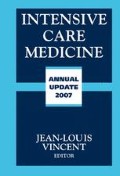Abstract
The development of noninvasive devices to manage hemodynamics in patients with shock is directly prompted by the results of recent studies in the intensive care unit (ICU), and during the perioperative period, which demonstrated the inability of an invasive approach, based on right heart catheterization, to improve prognosis [1]. Some authors have suggested that these results were largely due to inaccurate use of right heart catheterization, without clear goals or protocol [2], However, previous studies have demonstrated that optimization of cardiac output and mixed venous oxygen saturation (SvO2) with clear endpoints also fails to improve prognosis [3]. So, the lack of efficacy is inherent in the device. In 1985, Eugene Robin suggested that using right heart catheterization in patients with shock led physicians to give fluids plus diuretics whatever the wedge pressure [4]. In 2003, Francois Jardin claimed that we were going to move from the “age of oil lamps” to the “age of elec-tricity” [5]. In fact, we are going to change our practices in the management of shock, from an invasive and quantitative approach of hemodynamics to a non-invasive one, more functional and especially qualitative, mainly thanks to the use of echocardiography. This leads us to think about the meaning of hemodynamic monitoring.
Access this chapter
Tax calculation will be finalised at checkout
Purchases are for personal use only
Preview
Unable to display preview. Download preview PDF.
References
Shah M, Hasselblad V, Stevenson L, et al (2005) Impact of the pulmonary artery catheter in critically ill patients: meta-analysis of randomized clinical trials. JAMA 294:1664–1670
Pinsky M, Vincent JL (2005) Let us use the pulmonary artery catheter correctly and only when we need it. Crit Care Med 33:1119–1122
Boldt J (2002) Clinical review: hemodynamic monitoring in the intensive care unit. Crit Care 6:52–59
Robin E (1985) The cult of the Swan-Ganz catheter. Overuse and abuse of pulmonary flow catheters. Ann Intern Med 103:445–449
Jardin F (2003) Ventricular interdependance: how does it impact on hemodynamic evaluation in clinical practice ? Intensive Care Med 29:361–363
Toussignant C, Walsh F, Mazer C (2000) The use of transesophageal echocardiography for preload assessment in critically ill patients. Anesth Analg 90:351–355
De Backer D, Heenen S, Piagnerelli M, Koch M, Vincent JL (2005) Pulse pressure variations to predict fluid responsiveness: influence of tidal volume. Intensive Care Med 31:517–523
Vieillard-Baron A, Chergui K, Rabiller A, et al (2004) Superior vena caval collapsibility as a gauge of volume status in ventilated septic patients. Intensive Care Med 30:1734–1739
Tavernier B, Makhotine O, Lebuffe G, Dupont J, Scherpereel P (1998) Systolic pressure variation as a guide to fluid therapy in patients with sepsis-induced hypotension. Anesthesiology 89:1309–1310
Combes A, Arnoult F, Trouillet JL (2004) Tissue Doppler imaging estimation of pulmonary artery occlusion pressure in ICU patients. Intensive Care Med 30:75–81
Charron C, Caille V, Jardin F, Vieillard-Baron A (2006) Echocardiographic measurement of fluid responsiveness. Curr Opin Crit Care 12:249–254
Jardin F, Vieillard-Baron A (2006) Ultrasonographic examination of the venae cavae. Intensive Care Med 32:203–206
Barbier C, Loubieres Y, Schmit C, et al (2004) Respiratory changes in inferior vena cava diameter are helpful in predicting fluid responsiveness in ventilated septic patients. Intensive Care Med 30:1740–1746
Vieillard-Baron A, Prin S, Chergui K, Dubourg O, Jardin F (2003) Hemodynamic instability in sepsis: bedside assessment by Doppler echocardiography. Am J Respir Crit Care Med 168: 1270–1276
Jardin F, Valtier B, Beauchet A, Dubourg O, Bourdarias JP (1994) Invasive monitoring combined with two-dimensional echocardiographic study in septic shock. Intensive Care Med 20:550–554
Vieillard-Baron A, Charron C, Chergui K, Peyrouset O, Jardin F (2006) Bedside echocardio-graphic evaluation of hemodynamics in sepsis: is a qualitative evaluation sufficient? Intensive Care Med 32:1547–1552
Zapol W, Snider M (1977) Pulmonary hypertension in severe acute respiratory failure. N Engl J Med 296:476–480
Vieillard-Baron A, Schmitt JM, Augarde R, et al (2001) Acute cor pulmonale in acute respiratory distress syndrome submitted to protective ventilation: incidence, clinical implications, and prognosis. Crit Care Med 29:1551–1555
Dhainaut JF, Pinsky M, Nouria S, Slomka F, Brunet F (1997) Right ventricular function in human sepsis: a thermodilution study. Chest 112:1043–1049
Groeneveld A, Berendsen R, Schneider A, Pneumatikos I, Stokkel L, Thijs L (2000) Effect of the mechanical ventilatory cycle on thermodilution right ventricular volumes and cardiac output. J Appl Physiol 89:89–96
Hoeper M, Tongers J, Lepeprt A, Baus S, Maier R, Lotz J (2001) Evaluation of right ventricular performance with a right ventricular ejection fraction thermodilution catheter and MRI in patients with pulmonary hypertension. Chest 120:502–507
Vieillard-Baron A, Prin S, Chergui K, Dubourg O, Jardin F (2002) Echo-Doppler demonstration of acute cor pulmonale at the bedside in the medical intensive care unit. Am J Respir Crit Care Med 166:1310–1319
Jardin F, Dubourg O, Bourdarias JP (1997) Echocardiographic pattern of acute cor pulmonale. Chest 111:209–217
Gattinoni L, Brazzi L, Pelosi P, et al (1995) A trial of goal-oriented hemodynamic therapy in critically ill patients. SvO2 Collaborative Group. N Engl J Med 333:1025–1032
Varpula M, Tallgren M, Saukkonen K, Voipio-Pulkki L, Pettila V (2005) Hemodynamic variables related to outcome in septic shock. Intensive Care Med 31:1066–1071
Estenssoro E, Dubin A, Laffaire E, et al (2002) Incidence, clinical course, and outcome in 217 patients with acute respiratory distress syndrome. Crit Care Med 30:2450–2456
Author information
Authors and Affiliations
Editor information
Editors and Affiliations
Rights and permissions
Copyright information
© 2007 Springer Science + Business Media Inc.
About this paper
Cite this paper
Vieillard-Baron, A. (2007). The Meaning of Hemodynamic Monitoring in Patients with Shock: Role of Echocardiography. In: Vincent, JL. (eds) Intensive Care Medicine. Springer, New York, NY. https://doi.org/10.1007/978-0-387-49518-7_44
Download citation
DOI: https://doi.org/10.1007/978-0-387-49518-7_44
Publisher Name: Springer, New York, NY
Print ISBN: 978-0-387-49517-0
Online ISBN: 978-0-387-49518-7
eBook Packages: MedicineMedicine (R0)

